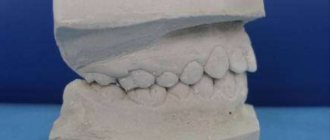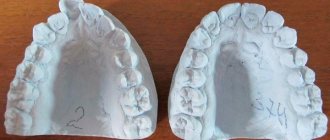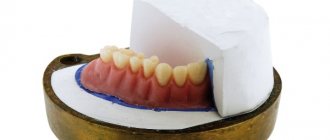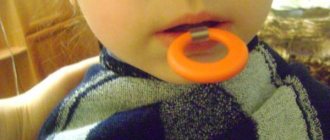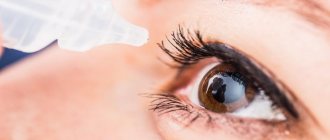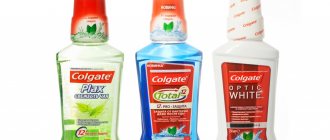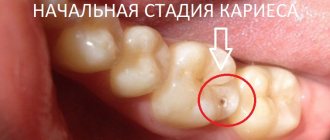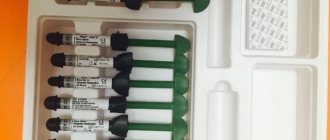3257
Correcting dental defects often requires major surgical procedures.
Restoration of bone tissue in the oral cavity and facial area after surgery is a pressing problem.
In this regard, the selection of effective drugs is very important for the successful treatment of teeth and jaw bones. One of these medications is KollapAn.
About the drug
The drug KollapAn is used for restoration of bone tissue, counteracting and treating suppuration and cystic formations.
The drug can replace damaged areas of bones, counteracts infectious phenomena for up to twenty days, uniformly providing an antibiotic effect.
The composition of the drug includes:
- synthetic hydroxyapatite;
- collagen compounds;
- active elements (lincomycin hydrochloride salts, gentamicin compounds, metronidazole, etc.).
Depending on the active element, subtypes of the drug are distinguished, which is reflected in the letter in the name. For example, KollapAna-L contains hydrochloride salts of lincomycin.
When using one or another subtype, you need to pay special attention to the active substance, since the speed of healing and the antibiotic effect, as well as the risk of developing allergic reactions, depend on its choice.
The use of antibiotics of different types and methods of action in the drug makes it possible to select the composition in such a way as to most effectively fight a particular infection and successfully suppress it.
Indications for oroantral communication plastic surgery and possible complications.
Read here about the properties and purpose of collagen membrane.
At this address https://www.vash-dentist.ru/hirurgiya/operatsii-na-zubah/koronoradikulyarnoy-separatsii.html you will find detailed information about performing coronoradicular tooth separation.
Allergy to materials used in orthopedic dentistry
Allergology studies a person’s relationship with the outside world and forms of disruption of the immune system’s response when the patient’s body becomes hypersensitive to certain substances. Allergic diseases, such as bronchial asthma, have been known since ancient times, but allergology became an independent medical and scientific discipline only in the middle of the twentieth century.
In recent decades, allergic diseases have become a global medical and social problem. There is a constant increase in incidence. Today, about 10% of the world's population is susceptible to allergies in one form or another, and this figure can vary greatly - from 1 to 50% or more in different countries, regions, and among individual population groups. Currently, there is an increase in the number of severe forms of allergic diseases, which leads to temporary disability, decreased quality of life and even disability. In this regard, early diagnosis of allergic diseases, correct methods of treatment and prevention are of great importance.
An allergen is a substance that enters the body and causes a certain type of immune response, resulting in damage to body tissue. We are surrounded by 5 million xenobiotics, many of them are allergens. The allergist's task is to identify the causative allergen.
Allergic diseases are a group of diseases, the development of which is based on damage caused by the immune reaction to exogenous allergens.
The classification of allergic reactions proposed by P. Cell and R. Coombs (1968) has become widespread throughout the world. It is based on the pathogenetic principle. The classification is based on the characteristics of immune mechanisms.
Type I - reaginic, anaphylactic. IgE-class antibodies and, less commonly, IgG antibodies participate in the development of the reaction. Clinical manifestations: bronchial asthma, allergic rhinitis, atopic dermatitis.
Type II - cytotoxic. It is called a cytotoxic type of tissue damage because antibodies formed to cell antigens bind to cells and cause their damage and even lysis (cytolytic action). In the clinic, the cytotoxic type of reaction can be one of the manifestations of drug allergies in the form of leukopenia, thrombocytopenia, hemolytic anemia, etc. The immune mechanism of the reaction is caused by IgG and IgM antibodies.
Type III - damage by immune complexes. The damage in this type of allergic reaction is caused by antigen + antibody immune complexes. Synonyms: immune complex type, Arthus phenomenon. IgG and IgM antibodies are involved in the development of the reaction.
Type III allergic reactions are leading in the development of serum sickness, exogenous allergic alveolitis and other diseases.
Type IV is a delayed-type allergic reaction, the development of which involves sensitized lymphocytes. Allergic reactions occur in sensitized people 24–48 hours after contact with the allergen. The typical clinical manifestation is contact dermatitis.
Thus, an allergy is an immune reaction of the body, accompanied by damage to its own tissue.
In recent years, an increase in life expectancy, new opportunities that have appeared in ordontology - all this makes us think about the mechanisms of occurrence of certain complications when using materials for dentures.
Metal and plastic dentures can cause not only allergic, but also toxic stomatitis, as well as mechanical irritation.
There are certain requirements for materials used for dental prosthetics. Among other things (hardness, aesthetics, etc.), materials must be chemically resistant to the environment in the oral cavity, created with the participation of saliva, nutrients and microbes. These factors can enhance the processes of metal dissolution and oxidation.
Dentures should not have a harmful effect on the oral mucosa and the body as a whole. Materials that are electrochemically neutral relative to each other should be selected.
For the manufacture of metal prostheses, about 20 metals are used - stainless steels, cobalt chrome, silver-palladium alloys, alloys based on gold and platinum. For metal-ceramics - nickel-based alloys, which include iron, chromium, titanium, manganese, silicon, molybdenum, cobalt, palladium, zinc, silver, gold and other metals.
To join dental alloy parts, solders containing silver, copper, manganese, zinc, magnesium, cadmium and other elements are used.
Low-melting alloys used for dies contain lead, tin, bismuth and some other substances.
The development of allergies is facilitated by the severity of electrochemical processes (corrosion) in the oral cavity, which depends on the structure of alloys, heterogeneity of metals, temperature conditions during the manufacture of metal prostheses, the chemistry of saliva and other factors.
Nickel is a component of stainless steel used for orthopedic treatment. In the oral cavity, nickel corrodes under the influence of saliva, causing allergic reactions.
For patients with a history of developing nickel dermatitis from wearing watch bracelets, clothing parts (zippers, clasps), jewelry, the use of this material is not indicated.
Chromium is used for dental prosthetics in the form of cobalt chromium and other alloys. It can have a wide range of effects on the human body, including causing allergic reactions.
Allergic complications can occur when using manganese and cobalt. In patients with allergic stomatitis caused by stainless steel dentures, antihapten antibodies to manganese are found in the blood.
An insoluble aluminum compound, kaolin (aluminum silicate), is used in dentistry as a filling material.
Iron is a metal characterized by corrosion resistance. Does not cause allergic complications.
Copper is an integral part of gold alloys of 750 and 900 samples, solders, and copper amalgam. Electrochemical processes between metal structures in the oral cavity lead to an increase in copper content in saliva, gastric juice and blood. Toxic reactions are possible.
Zinc oxide is part of dental cement, dental amalgams, solders, and brass. Zinc is more active than iron. In the presence of moisture, these metals form a microgalvanic couple in which zinc is the anode, therefore, when metal dentures corrode in the oral cavity, zinc dissolves first. The toxicity of zinc compounds when ingested is low.
When using metal prostheses, the lead content in saliva is increased. Lead is a corrosive metal and has a toxic effect.
Tin is part of low-melting alloys for models used for making crowns. Tin compounds are toxic and are not used in medicine.
Titanium is a component of stainless steel for dentures. The biological role of titanium has not been sufficiently studied.
Molybdenum is low-toxic and is included in stainless steel as an alloying additive.
Indium is a component of solder for stainless steel and is low-toxic.
Arsenic, which is used in dentistry for dental treatment, has significant toxicity.
Silver is part of alloys (silver-palladium, 750 gold, etc.) used in orthopedic treatment. Considering the bactericidal, anti-inflammatory effect of silver, silver-palladium alloy is recommended for use in chronic diseases of the mucous membranes of the oral cavity and gastrointestinal tract.
Gold has high corrosion resistance and is included in gold alloys and solders for dentures.
Platinum metals (palladium, platinum, etc.) are not poisonous. Palladium is part of the silver-palladium alloy for dentures. Platinum group metals, including palladium, are allergens.
Currently, superelastic materials with shape memory have been created. This direction is very promising and determines the future of orthodontics. An example is titanium nickelide (Ti, Ni, Mo, Fe).
The greatest role in the occurrence of sensitization to metal prostheses is played by the haptens they contain (nickel, chromium, cobalt, manganese). They become antigens only after combining with proteins of body tissues. As a result, so-called conjugated antigens are formed.
Plastics used in dentistry for orthopedic treatment are high-polymer organic compounds. Acrylic plastic can cause allergic and toxic stomatitis. The main etiological factor in the development of allergies to acrylic is considered to be the residual monomer contained in plastic in an amount of 0.2%. If the polymerization regime is violated, its concentration increases to 8%.
Allergies can also be observed to dyes used in aesthetic dentistry.
Ceramics does not cause allergic complications.
Let us note a number of nonspecific factors that contribute to the penetration of hapten from the oral cavity into the blood, increasing its dose and thereby increasing the risk of developing an allergic disease.
- Disruption of heat exchange processes under removable acrylic dentures. An increase in temperature promotes loosening and maceration of the mucous membrane of the prosthetic bed, increasing vascular permeability, which, in turn, creates conditions for the penetration of hapten (monomer) into the bloodstream.
- Mechanical trauma to a removable denture during chewing leads to the development of inflammation of the prosthetic bed.
- Electrochemical (corrosive) processes in the oral cavity between metal dentures contribute to an increase in the amount of metal haptens in saliva and mucous membranes.
- A change in the pH of saliva towards increased acidity leads to the development of corrosion processes in metal and plastic structures. At the same time, the release of haptens (metals, monomer, etc.) into saliva and mucous membranes increases.
- The processes of abrasion of dental materials lead to an increase in the content of their components in saliva, and the risk of sensitization increases.
During inflammation, the barrier function of the mucous membrane is disrupted. The permeability of the mucosa is directly dependent on the chemistry of saliva.
It is necessary to differentiate between allergic stomatitis caused by the prosthesis, stomatitis of gastroenterological origin, as well as candidiasis.
Stomatitis can be a manifestation of a disease of the endocrine system (diabetes, pathological menopause), skin (lichen planus) or systemic disease (Sjogren's syndrome).
Complaints may be caused by a decrease in occlusal height (Costen syndrome), manifestations of galvanism, and toxic reactions.
Galvanism occurs after the first contact of the mucous membranes of the oral cavity with irritants. Such stimuli are a variety of potentials (microcurrents) between dissimilar materials.
Allergic stomatitis should be distinguished from toxic reactions to metal prostheses. Toxic stomatitis is characterized by rapid development after orthopedic treatment (stomatitis, gingivitis, glossitis).
A qualitative and quantitative assessment of the spectrogram of saliva is carried out to identify the toxic dose of heavy metals. Assessing the quality and correctness of the designs of removable dentures in the oral cavity helps to differentiate between mechanical irritation and toxic and allergic stomatitis.
To diagnose the nature of complications, it is necessary to collect a dental and allergy history. An allergic history includes identifying the patient’s hereditary predisposition to allergic diseases. It is necessary to find out whether the patient suffers from allergic rhinitis, bronchial asthma, eczema, drug and food allergies, i.e., in other words, whether he has an allergic constitution.
An examination of the patient, including the oral cavity, is necessary. Elimination and exposure tests are widely used in orthopedic dentistry. When the denture is removed, i.e. during elimination, the number of clinical symptoms sharply decreases or disappears for a period of time (3–5 days).
To confirm the allergic nature of the disease, it is necessary to conduct additional immunological tests and, in particular, for the presence of antibodies to plastic and metals. The achievements of today's immunological laboratory diagnostics include examination using 8 tests to identify the true mechanism of allergy:
IgE a/t - antibodies in blood serum; IgE b - antibodies on basophils; IgG a/t - antibodies in blood serum; IgG n - antibodies on neutrophils; TlS - T-lymphocyte sensitization in the IL-2 stimulation test; AGT - platelet aggregation under the influence of allergens; IPLA—inhibition of leukocyte adhesion by allergens; RGML is a reaction of inhibition of lymphocyte migration under the influence of allergens.
If the content of haptens - nickel, chromium, cobalt, manganese - increases in saliva by more than 1x10-6%, the dentures should be removed. An increase in the content of microelements that have a toxic effect (copper, cadmium, lead, bismuth, etc.) is also a reason for removing the prosthesis.
To diagnose allergies, you can use skin tests (drop tests, prick tests, etc.). In order to identify contact allergies to nickel and chromium, alcohol solutions of metal salts are used. You can use a skin patch test, as well as conduct a patch test on the oral mucosa. It should be noted that skin and provocative tests should be carried out only in an allergy office by an allergist with the necessary experience.
Galvanic intolerance is observed in 6% of people using stainless steel dentures. The disease occurs 3 times more often in women than in men. Clinically, the disease was manifested by a sensation of “current passing” and a taste disorder that developed in the first days after prosthetics. In the presence of an allergic process, irritation of the oral mucosa, redness, swelling, as well as distant manifestations of allergy (skin rash with nickel dermatitis) occur.
PH-metry of saliva and potentiometry (measurement of electrode potentials of dentures) are not very informative.
When treating electrogalvanic intolerance, metal inclusions should be completely removed, followed by replacement with appropriate structures made of noble alloys. Similar tactics should be adopted if an allergy to chromium or nickel is detected.
Elimination of allergies can be achieved not only by removing the prosthesis from the oral cavity, but also by shielding (chemical silvering of the prosthesis) and gold electroplating of solid-cast devices.
Diagnosing intolerance of an allergic nature can only be done through a thorough analysis of complaints, anamnesis and the results of clinical and allergological examination of patients.
In the presence of allergic complications (stomatitis, eczema), antihistamines and symptomatic drugs are used. For severe allergic reactions, glucocorticoids are used.
If allergic stomatitis develops, it is necessary to prescribe the patient antihistamines in injection or tablet form. The priority is the intramuscular administration of first-generation antihistamines - suprastin and tavegil, since the development of the allergic process can cause pain in the oral cavity and make it difficult to take both food and medications.
Antihistamines that block H1 receptors are quite safe. First-generation H1 blockers are rapidly absorbed both when taken orally and when administered by injection. Their pharmacological effect appears after 30 minutes. Most drugs are excreted in the urine after 24 hours in an inactive form. The disadvantage of these drugs is the fact that many first-generation drugs cause dry mouth, which can increase the symptoms of oral discomfort.
The activity of H1-blockers is approximately the same, therefore, when choosing a drug, they are guided by its side effects, experience with use and effectiveness in a given patient. First-generation H1 antagonists, at least in the near future, will remain in the arsenal of drugs that are in wide clinical use. This is facilitated by 50 years of experience in the use of these drugs, and the availability of injectable dosage forms that are absolutely necessary for the treatment of acute allergic conditions. In addition, it should be noted the relatively low cost of this group of drugs.
Since the late 70s. Second generation antihistamines began to be used in widespread medical practice. It should be noted that they are highly selective in blocking H1 receptors and lack blockade of other receptors. The effect of the drugs begins to appear 20 minutes after administration and lasts for quite a long time - up to 24 hours. These drugs are produced only in tablet form. They are used 1 or 2 times a day, which is preferable to taking 1st generation antagonists 3 times a day. Second-generation antihistamines do not cause addiction, as well as sedative and cholinergic effects.
Thus, second-generation antihistamines (Telfast, 180 mg; Claritin, Erius, Zyrtec) are considered an alternative to drugs for parenteral administration in the absence of severe pain in the oral cavity. Considering the fact that fexofenadine (Telfast) is a final metabolite and does not undergo further transformations in the liver, it can be prescribed to patients with pathology of this organ.
If chewing and swallowing food is difficult, you can use toothpastes containing anesthetics. Soda rinses are used as a softening agent.
Since the oral cavity contains many microbes (up to 400 species), oral care is very important. It is necessary to regularly rinse your mouth with furacillin solution. You can use KMnO4 (weak pink solution).
When a secondary infection occurs, broad-spectrum antibiotics should be prescribed. Second-generation macrolides (sumamed, rulide, rovamycin) have proven themselves well in clinical practice. Rovamycin can be used in injection form. In severe cases, quinolone drugs (Tarivid, Maxaquin, Tsiprobay, etc.) are prescribed. It is advisable to do a culture of the oral cavity for bacterial flora and fungi to determine the sensitivity of the microflora to various antibiotics in order to prescribe etiotropic treatment.
In case of severe erosive processes in the oral cavity, glucocorticoids are administered for health reasons. It should be noted that prednisolone is considered the shortest-acting glucorticoid and should be administered at least 4 times a day. More preferable is the use of dexamethasone 4-8 mg 2-3 times a day or the drug celeston, 1.0-2.0, twice a day for 5-7-10 days. Positive experience has been accumulated in the use of long-acting drugs, such as diprospan, 1.0-2.0, which is administered once.
When symptoms of dermatitis in various parts of the body appear, which is often observed when installing prostheses containing nickel and chromium, antihistamines are also prescribed. Treatment with local and systemic glucocorticoids follows general principles. It should be noted that there are various forms of glucocorticoids used externally: ointments, creams, lotions. In recent years, the drugs Elokom and Advantan have been widely used in clinical practice. These glucocorticoids can also be used on the face. When the skin becomes infected, combined agents are prescribed: Triderm, celestoderm with garamycin. In the presence of a purulent infection, antibiotics in tablet or injection form are indicated.
When the acute allergic process subsides after 7–10 days, you can switch to local non-hormonal anti-inflammatory drugs. A good effect is observed when using Elidel cream. In the third or fourth week of the disease, you can use moisturizers: toleran, lipicar, cold cream, etc. For lips, use a balm with cold cream, ceralip. Aevit, complexes of vitamins with microelements, is also prescribed.
It should be noted that allergic diseases caused by the use of materials for dentures are highly curable and have a favorable prognosis with a full course of treatment adequate to the severity of the patient’s condition.
Yu. V. Sergeev , Doctor of Medical Sciences, Professor T. P. Guseva Institute of Allergology and Clinical Immunology, Moscow
Types, composition and pharmacological properties
As noted above, preparations of the collapan group differ from each other in the type of active antimicrobial substance used in their manufacture.
So:
- the letter “G” means that the composition includes gentamicin elements;
- letter “K” - substances of the claforan group;
- letter "M" - metronidazole;
- letter “P” - antibiotics of the rifampic type;
- letter "D" - dioxidin;
- the letter “I” is an isoniazidine active substance.
CollapAn, according to the type of pharmacotherapeutic group, refers to drugs that fill the cavities of jaw fragments.
Pharmacological characteristics
The medication is a fine powdery composition of hydroxyapatite elements embedded in a collagen base with the addition of an antibiotic. Collagen has unique properties.
Due to its structure, it is non-toxic, non-carcinogenic, practically does not cause allergic reactions, is fully processed by the body, binds well to the active substances of drugs and triggers restoration processes in damaged areas.
The effect of the drug is based on the fact that the active substances do not penetrate the damaged areas immediately, but throughout the entire duration of its action.
This makes it possible to gradually restore bone tissue through the formation of calcium and phosphorus ions, which are introduced into the composition of the restored bone formations and accelerate healing.
The substances that make up KollapAn become the basis for the growth of restored areas . As they dissolve, they create growth points on themselves where active biological elements settle.
This process allows the formation of a prototype of the created solid fragments by accumulating minerals. The growth occurs directly on the drug molecules.
The emerging cartilaginous base then hardens and becomes mature bone. At the same time, the features of the drug allow you to avoid complications, there is practically no intolerance, which allows you to restore significant areas of damaged bones in a relatively short time.
Antimicrobial properties combined with the gradual release of the active substance provide reliable protection against inflammation throughout the entire treatment period.
The antibiotic procedure performed reduces the risk of further development of infectious processes.
Thus, KollapAn, thanks to an integrated approach, allows you to have an effective effect on damaged areas, restoring them health and strength.
Type of osteoplasty
Below are the main types of osteoplasty to understand for which surgical interventions a specific type of material is used:
- autotransplantation. This is a procedure that involves moving a tooth from one place to another in order to fill a visually and functionally significant defect. Eighth molars (wisdom teeth) are most often transplanted. As a result of the operation, the bone tissue becomes significantly wider;
- sinus lift. This is a surgical intervention that is performed on the upper jaw in order to increase the length of bone tissue in case of its deficiency.
It is possible to increase the volume of bone tissue through the use of materials of synthetic origin. Barrier membranes are used to fix transplanted bone tissue or to protect a person’s bone tissue after a molar or premolar has been removed. Allografts are used to restore bone tissue. The most common are autografts.
Areas of application
Collapan is widely used in all areas related to the surgical treatment of bones, such as traumatology and orthopedic areas, neurosurgical procedures and surgical interventions for the treatment of the spine, elimination of suppuration and in the field of military surgery.
It is used to fill damaged areas and carry out antimicrobial treatment. To treat a specific infectious lesion, you can select a specific antibiotic included in the drug as an active substance. This allows for more effective therapy.
Surgical periodontology
During the surgical treatment of periodontal diseases , soft tissues are lifted, after which the surface is cleaned of mineralized formations of tartar, damaged fragments and bone tumors.
The doctor shapes the areas to be restored, sharp edges are processed. The operated areas are subjected to antimicrobial treatment and drying.
In areas where the fragment has failed and needs to be restored, portions of KollapAn are administered.
The video presents a scheme for the treatment of periodontitis using Kollapan granules.
Surgical dentistry
When removing teeth with complications, the remaining cavity from the root is diagnosed for dentin residues and potential bleeding, antimicrobial treatment and drying are performed.
A dose of the drug is placed in the cavity and the wound is treated. If there is a threat of alveolitis, additional procedures are performed under anesthesia, after which the damaged area once again undergoes antimicrobial therapy.
If the wound is bleeding, then Kollapan is applied and stitches are applied. In the future, the operated area does not require additional manipulations.
When truncation of a section of the tooth root and cupping of the damaged area, the resulting depression is filled with KollapAn, and blind sutures are applied. Thus, complete replacement of deleted areas with new fragments is ensured.
Dental implantation
After permanent prosthetics and implantation, damaged areas of the jaw that require rapid healing and visible parts of the dentures are treated with KollapAn.
This improves survival rate and eliminates the likelihood of developing suppuration and inflammatory processes.
When treating peri-implatitis diseases, the affected hard and soft tissues are diagnosed and cleaned. This removes inflammatory foci of the mucous membrane in the areas around the implants.
Treatment is carried out with antimicrobial agents and KollapAn, previously crushed and brought to a homogeneous state.
Sinus lifting procedures produce a serious impact on the jaw. A procedure is carried out to separate the soft tissues, the bone tissue is built up by filling it with KollapAn.
Maxillofacial Surgery
During such operations, defective areas of the facial bones are restored, and foci of infection are eliminated.
These can be either injuries or past illnesses. In this case, defects can be expressed in the presence of voids, curvatures, weakening and thinning of areas.
Therapy includes antimicrobial treatment, drying and filling with KollapAn substances.
In case of damage or puncture of the sinuses of the upper jaw, an examination is first performed, during which the degree of injury is revealed.
After this, the affected areas are removed from the cavity, the boundaries of the bone tissue located in the treatment area are processed, and treated with an antiseptic composition.
If suppuration is present, they are additionally disinfected . After this, the cavity is filled with the drug.
Stages of the operation to remove stones from the salivary gland and the equipment used.
In this article we will discuss indications for tooth reposition.
Follow the link https://www.vash-dentist.ru/hirurgiya/operatsii-na-zubah/kogda-opravdano-sekvestrektomii.html if you are interested in what sequestrectomy is and in what cases it is prescribed.
Lower jaw implantation
The lower jaw is denser in structure than the upper jaw, so in most cases, 4 to 6 implants are enough to restore all teeth.
Fixed prosthetics of the lower jaw are performed on 6 implants with classical implantation. It is also possible to restore teeth on 4 implants using the all-on-4 method, in which case 2 of the 4 implants are placed at an angle of up to 45 degrees. The technique has its pros and cons.
Fixed prosthetics completely imitate your own teeth and are the easiest to tolerate psychologically. During the period of implant integration, the patient uses a temporary removable prosthesis, or dental implantation is carried out with a simultaneous load using a fixed plastic prosthesis.
In the case when a permanent prosthesis is made with screw fixation, we are talking about conditionally removable prosthetics on implants. Conditionally removable means that the prosthesis can only be removed by a dentist. The patient cannot remove it on his own; it feels and functions like his own teeth.
The advantages of screw fixation are that the prosthesis can be removed if necessary. Unlike cemented dentures, which cannot be removed without sawing them. However, the complexity of the design, and as a consequence the cost, is increasing.
Expected Result
X-ray studies show that within two to four months after using KollapAn:
- the restoration process began;
- healthy bone tissue was formed;
- defective areas were eliminated;
- within two years, signs of the disease disappeared.
When the drug is applied locally, in most patients, the damaged areas are completely replaced with a sponge-type mass.
There are practically no cases where KollapAn has no positive effect on the patient’s body.
Low effectiveness of treatment is only possible if the patient violates the doctor’s recommendations, or if the drug is used incorrectly, including an incorrectly selected antimicrobial substance.
The operated areas treated with the drug are quickly restored, there is no purulent discharge.
CollapAn can be combined with other restorative and antimicrobial medications , which can increase the effectiveness of treatment and reduce the risk of complications.
As a result, the patient can completely get rid of problems after suffering diseases of the maxillofacial region.
Cases of allergies to CollapAn, as well as contraindications due to intolerance to the drug, have not been identified.
Reviews
Recovery after surgery in the mouth and jaw is a very painful process.
Many factors can interfere with healing. Today there are many drugs on the pharmaceutical market. But from them I want to choose the most effective at an affordable price.
Those who have encountered similar problems and used drugs for treatment that restore the jaw bone (including KollapAn), we advise you to leave your feedback in the comments section.
If you find an error, please select a piece of text and press Ctrl+Enter.
Tags medicines operation
Did you like the article? stay tuned
Previous article
Purpose of Ribbon tape in dentistry and functions assigned to the product
Next article
Distalization of molars – correction of bite defects at any age
How much does implantation cost if there are no teeth?
Despite the apparent high cost of implantation in the absence of teeth, it may turn out to be more profitable than restoring already hopeless teeth. In addition, the service life of implants is unlimited. Treatment is carried out in stages and is also paid for.
So, the price of jaw implantation in the absence of teeth depends on the type of structure (metal-plastic, metal-ceramic) and the implant system.
The cost of jaw implantation on 6 ROOT implants (Switzerland) with a metal-plastic prosthesis starts from 150,000 rubles. It is possible to replace the metal-plastic structure with a metal-ceramic one at a cost of 90,000 rubles.
The cost of jaw implantation on 4 Snucone implants (South Korea) with a metal-plastic prosthesis starts from 160,000 rubles.
